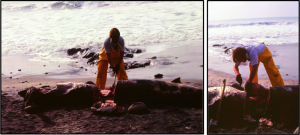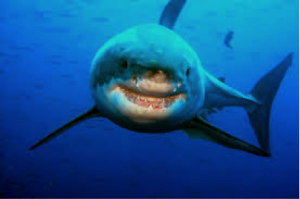By Roger Helm (4 February 2016)

“These suckers are HUGE” I remember my brother saying as he took pictures of me dissecting a female Great White Shark that had washed ashore opposite Año Nuevo Island in 1978. And boy was he right. While this shark was a bit over 5m long from the tip of her nose to the end of her upswept tail, she was 4m in girth at her pectoral (shoulder) fins. It’s a bit misleading to say I was ‘dissecting’ this behemoth. Each time I tried to penetrate the prehistoric placoid scale hide of her back and flanks with the sharp tip of my flensing knife the stiff blade bent like a bow. Lacking a chainsaw, I conducted much of my ‘dissection’ with a razor sharp axe.

After finally gaining access to her abdomen I sorted through the endless gobs of a shark’s liver to reach her stomach. As the contents of her stomach quickly revealed there is good reason that Great Whites make Año Nuevo and its large Northern Elephant Seal colony a favored stop on their great annual migrations. This gal had recently been feasting as her stomach contained several fresh massive pieces of a four- to five-year-old male elephant seal. Individual bites included: four 15+ pound pot roast-sized chunks of blubber and muscle; the left fore flipper, including scapula; the entire hindquarters including both hind flippers; and the head back to the 3rd cervical vertebra. Together these pieces weighed well in excess of a hundred pounds and after digesting these huge meatballs she probably would have relished an industrial-sized bottle of Tums. While that ‘dissection’ was quite amazing to me, it really just serves as the preamble to my main subject, the story of Dr. G. Victor Morejohn and the Great White Shark Hunt on the Rolling O.
Between 1977 and 1978 I served as Dr. Morejohn’s Graduate Teaching Assistant for his Marine Vertebrates and Marine Birds and Mammals classes and as the marine vertebrate technician in the Moss Landing Marine Laboratories museum. In the latter position I traveled all over Monterey Bay to slice and dice stranded animals to obtain teaching and exhibit specimens for Dr. Morejohn’s classes. It was in early spring 1978 that I responded to a call to ‘dissect’ the Great White Shark. I still remember feeling the charge of Dr. Morejohn’s building excited energy when I shared my adventure and specimens with him a few days later. As a man deeply consumed by the natural history of vertebrates, Vic Morejohn always wanted to know, at a visceral level, as much as he possibly could about animals that fascinated him.

Even today whenever I think about him, the first word that comes into my mind is grok. Coined by Robert A. Heinlein in his 1961 sci-fi novel, Stranger in a Strange Land, grok means to understand so thoroughly that the observer becomes a part of the observed and to fully grok something you had to consume at least part of it. Dr. Morejohn loved to deeply investigate, skillfully draw, and share his knowledge of the natural history of the animals he saw and captured. Also, like many classic biologists of bygone eras, he regularly savored the specimens he captured.
Similar to many in his fluid stream of Master’s students, I found Dr. Morejohn’s intensity, intellect, drawing skills, and consuming passion for understanding and teaching about the natural world a bit intimidating. However, when he got excited about something it was thrilling to be in his sphere of energy. Long before I finished relating my shark ‘dissection’ story, he had started formulating a plan to get the lab a real set of specimens. In his mind, MLML deserved far more than just the stomach contents and a few vertebra of a beach cast Great White Shark. Already his rivals at UC Santa Cruz had snared the jaws from the shark before they alerted their kid brother down the coast that a dead shark had washed ashore. What MLML really needed was to capture our own Great White Shark… and so began the G. Victor Morejohn Great White Shark hunt on the rolling O.
The follow up to this story will appear next week.
[For more stories about G. Victor Morejohn, please see the past blog posted at this site]: https://mlml.sjsu.edu/2015/12/03/g-victor-morejohn-one-of-a-kind/

